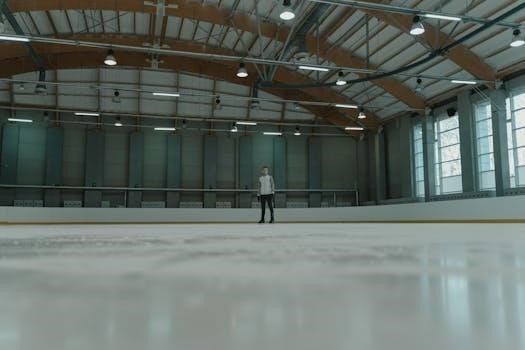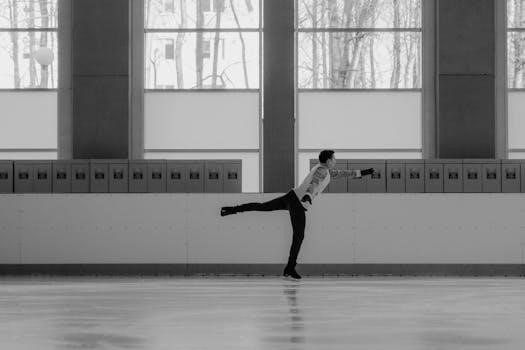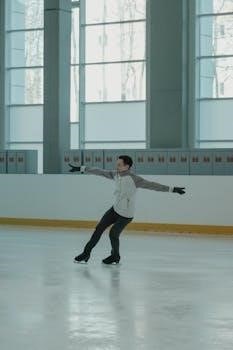Finding the right fit for your Jackson ice skates is crucial. This guide provides information to help you navigate the sizing process. Remember to consult official charts and consider a professional fitting for optimal comfort and performance on the ice.
Understanding Jackson Skate Sizing
Jackson ice skate sizing can be a little different from your regular shoe size. It’s important to understand that skate sizes aren’t always consistent across different brands or even different models within the Jackson line. Factors like the skate’s construction‚ intended use (recreational vs. competitive)‚ and even the skater’s skill level can influence the ideal size. Therefore‚ relying solely on your street shoe size isn’t recommended.
Jackson Ultima Retailers advise against depending on length charts alone for a proper fit. A good fit is essential for performance and comfort. Skates that are too big can lead to instability and make it harder to control your movements. Skates that are too small can cause discomfort and even blisters.
Always consider getting your feet professionally measured and fitted by a trained skate technician. This will ensure you get the best possible fit for your Jackson skates.

Importance of Proper Fitting
The fit of your ice skates is paramount for both performance and comfort on the ice. Poorly fitted skates can lead to a multitude of problems‚ hindering your progress and potentially causing injury. Skates that are too large offer inadequate support‚ making it difficult to maintain balance and execute precise movements. This lack of control can be frustrating and even dangerous‚ increasing the risk of falls and ankle sprains.
Conversely‚ skates that are too small can be equally problematic. Cramped toes and pressure points can lead to blisters‚ numbness‚ and other foot ailments‚ making skating an uncomfortable and even painful experience. Moreover‚ an improper fit can affect your skating technique. If your feet are not properly supported‚ you may compensate by adopting poor posture or incorrect movements‚ which can ultimately limit your skating potential and increase the risk of long-term injuries.
Therefore‚ investing the time and effort to ensure a proper skate fit is essential for a safe‚ enjoyable‚ and successful skating experience.
Jackson Ultima Retailer Fitting Recommendation
While online resources and size charts can be helpful starting points‚ Jackson Ultima strongly recommends seeking a professional fitting at an authorized retailer. These retailers possess the expertise and specialized equipment necessary to accurately assess your foot size and shape‚ ensuring an optimal skate fit.
Trained fitters can consider factors beyond simple length and width measurements‚ such as arch height‚ ankle shape‚ and individual skating goals. They can also evaluate different Jackson Ultima models to determine which best suits your foot type and skill level. Furthermore‚ authorized retailers often offer services like heat molding‚ which customizes the skate’s fit to the unique contours of your feet‚ enhancing comfort and performance.
By consulting a Jackson Ultima retailer‚ you gain access to personalized guidance and a wider selection of fitting options‚ minimizing the risk of discomfort or injury. This investment in professional fitting services ensures a secure and supportive fit‚ allowing you to focus on enjoying your time on the ice.
Measuring Your Foot Length

Accurately measuring your foot length is the first step in determining the correct Jackson ice skate size. To do this‚ wear the type of socks you typically wear while skating. Place a piece of paper against a wall and stand on it with your heel against the wall.
Ensure your weight is evenly distributed. Have someone trace your foot‚ or carefully trace it yourself‚ keeping the pen or pencil perpendicular to the paper. Measure the distance from the heel to the tip of your longest toe in centimeters or inches. Repeat this process for both feet‚ as they may differ slightly.
Use the longer measurement to determine your skate size using the Jackson size charts; Remember that these measurements are just a starting point‚ and professional fitting is always recommended for the best results. It’s also important to measure foot length regularly‚ especially for children‚ as feet can grow quickly.

Using Jackson Size Charts
Once you have accurately measured your foot length‚ the next step is to consult the official Jackson size charts. These charts provide a conversion from your foot measurement to the corresponding Jackson skate size. Jackson provides sizing charts for both men and women‚ as well as youth sizes‚ so ensure you are using the correct chart.
Locate your foot length measurement on the chart and find the corresponding skate size. Keep in mind that the size charts are a guideline. Factors like foot width and personal preference can influence the ideal skate size. If your foot measurement falls between two sizes‚ it’s generally recommended to try on both sizes to determine the best fit.
Always prioritize a comfortable and secure fit over strictly adhering to the size chart. Visiting an authorized Jackson Ultima retailer for a professional fitting is highly recommended. They can assess your foot and provide expert advice on the most suitable size and model for your needs.
Width Considerations
Beyond length‚ width is a crucial factor in achieving a proper skate fit. Jackson skates come in various widths‚ typically ranging from narrow to wide. Ignoring width can lead to discomfort‚ blisters‚ and reduced performance. A skate that’s too narrow will pinch and restrict movement‚ while a skate that’s too wide will allow the foot to slide‚ compromising stability.
To determine your ideal width‚ consider your foot shape and any previous skate experiences. If you consistently experience pressure on the sides of your feet in other skates‚ you likely need a wider width. Conversely‚ if your foot feels loose or unsupported‚ a narrower width may be more suitable.
Jackson size charts often include width indicators‚ providing a starting point for your selection. However‚ a professional fitting is invaluable. A qualified fitter can assess your foot’s width and recommend the appropriate skate width for optimal comfort and performance. Remember that width can vary between different Jackson models.
Sizing for Different Jackson Models
It’s important to note that sizing can vary slightly between different Jackson skate models. A size that fits perfectly in one model might not be the ideal size in another. This is due to variations in the boot’s construction‚ padding‚ and overall design.
Before purchasing a specific Jackson model‚ consult the model-specific size chart if available. These charts provide more accurate measurements tailored to that particular skate. If you’re unsure‚ it’s always best to try on the skates in person or seek guidance from a knowledgeable skate fitter.
Factors like the level of support offered by the skate can also influence sizing. For instance‚ a higher-level skate with more structured support might fit differently than a recreational skate with more flexibility. Always prioritize comfort and proper foot support when selecting a size‚ regardless of the model.
Remember to lace the skates fully when trying them on to get an accurate feel for the fit.
Fitting Skates⁚ Lacing Technique
Proper lacing is crucial for ensuring a correct and comfortable skate fit. The way you lace your skates can significantly impact ankle support‚ foot stability‚ and overall performance on the ice. Start by loosening the laces completely‚ allowing your foot to slide easily into the boot. As you begin lacing‚ ensure the tongue is centered and lies flat against your shin.
Pay close attention to the instep area‚ as this is where you’ll want to achieve a snug but not overly tight fit. Work your way up the boot‚ tightening the laces gradually‚ focusing on providing adequate support around the ankle. For figure skates‚ many skaters use a “lace lock” technique around the hooks to customize the tightness in the ankle area versus the lower foot.
Avoid overtightening the laces‚ as this can restrict circulation and cause discomfort or even numbness. The goal is to achieve a secure fit that allows for flexibility and movement while providing sufficient support. Experiment with different lacing techniques to find what works best for your foot shape and skating style.
Sizing for Youth Skates
Sizing youth skates requires extra attention‚ as children’s feet grow rapidly. Regular measurements are essential to ensure a proper fit and prevent discomfort or injury. Start by measuring the child’s foot length‚ following the same procedure as for adult skates. Use Jackson’s youth-specific size charts to determine the appropriate skate size based on the foot length.
Consider that youth skates often come in smaller sizes and narrower widths to accommodate growing feet. It’s generally recommended to allow a little extra room for growth‚ but not so much that it compromises stability and control. A thumb’s width of space between the toes and the end of the boot is a good guideline.
Pay attention to the overall fit‚ ensuring the heel is secure and the ankle is adequately supported. As children may not always be able to accurately communicate discomfort‚ carefully observe their skating technique and ask about any pressure points or rubbing. Regularly check the fit of the skates as the child’s feet grow‚ and consider upsizing when necessary.
Breaking in New Skates
Breaking in new ice skates is a crucial step to achieving a comfortable and high-performing fit. New skates can feel stiff and uncomfortable initially‚ as the materials need to mold to the unique contours of your feet. The breaking-in process softens the boot‚ allowing for greater flexibility and responsiveness on the ice.
Start by wearing the skates for short periods off the ice‚ gradually increasing the wear time. This helps the materials to adapt to your foot shape without causing excessive discomfort. Use skate guards to protect the blades during these sessions.
On the ice‚ begin with shorter skating sessions and focus on basic movements. As the skates break in‚ gradually increase the intensity and duration of your skating. Pay attention to any areas of discomfort or pressure points and address them with padding or adjustments to the lacing.

Professional skate fitters can also assist with the breaking-in process by using heat molding techniques to accelerate the adaptation of the boot to your foot. Remember that patience and persistence are key to successfully breaking in new skates and achieving a customized fit.
